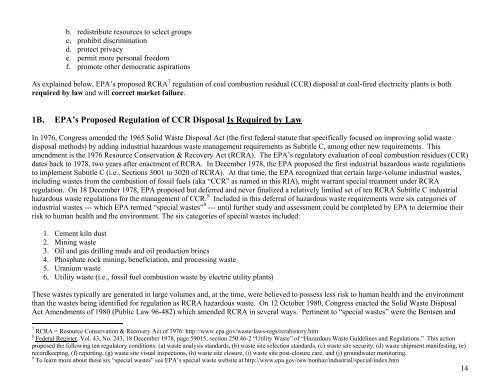Analysis - The Institute for Southern Studies
Analysis - The Institute for Southern Studies
Analysis - The Institute for Southern Studies
Create successful ePaper yourself
Turn your PDF publications into a flip-book with our unique Google optimized e-Paper software.
. redistribute resources to select groups<br />
c. prohibit discrimination<br />
d. protect privacy<br />
e. permit more personal freedom<br />
f. promote other democratic aspirations<br />
As explained below, EPA’s proposed RCRA 7 regulation of coal combustion residual (CCR) disposal at coal-fired electricity plants is both<br />
required by law and will correct market failure.<br />
1B. EPA’s Proposed Regulation of CCR Disposal Is Required by Law<br />
In 1976, Congress amended the 1965 Solid Waste Disposal Act (the first federal statute that specifically focused on improving solid waste<br />
disposal methods) by adding industrial hazardous waste management requirements as Subtitle C, among other new requirements. This<br />
amendment is the 1976 Resource Conservation & Recovery Act (RCRA). <strong>The</strong> EPA’s regulatory evaluation of coal combustion residues (CCR)<br />
dates back to 1978, two years after enactment of RCRA. In December 1978, the EPA proposed the first industrial hazardous waste regulations<br />
to implement Subtitle C (i.e., Sections 3001 to 3020 of RCRA). At that time, the EPA recognized that certain large-volume industrial wastes,<br />
including wastes from the combustion of fossil fuels (aka “CCR” as named in this RIA), might warrant special treatment under RCRA<br />
regulation. On 18 December 1978, EPA proposed but deferred and never finalized a relatively limited set of ten RCRA Subtitle C industrial<br />
hazardous waste regulations <strong>for</strong> the management of CCR. 8 Included in this deferral of hazardous waste requirements were six categories of<br />
industrial wastes --- which EPA termed “special wastes” 9 --- until further study and assessment could be completed by EPA to determine their<br />
risk to human health and the environment. <strong>The</strong> six categories of special wastes included:<br />
1. Cement kiln dust<br />
2. Mining waste<br />
3. Oil and gas drilling muds and oil production brines<br />
4. Phosphate rock mining, beneficiation, and processing waste<br />
5. Uranium waste<br />
6. Utility waste (i.e., fossil fuel combustion waste by electric utility plants)<br />
<strong>The</strong>se wastes typically are generated in large volumes and, at the time, were believed to possess less risk to human health and the environment<br />
than the wastes being identified <strong>for</strong> regulation as RCRA hazardous waste. On 12 October 1980, Congress enacted the Solid Waste Disposal<br />
Act Amendments of 1980 (Public Law 96-482) which amended RCRA in several ways. Pertinent to “special wastes” were the Bentsen and<br />
7 RCRA = Resource Conservation & Recovery Act of 1976: http://www.epa.gov/waste/laws-regs/rcrahistory.htm<br />
8 Federal Register, Vol. 43, No. 243, 18 December 1978, page 59015, section 250.46-2 “Utility Waste” of “Hazardous Waste Guidelines and Regulations.” This action<br />
proposed the following ten regulatory conditions: (a) waste analysis standards, (b) waste site selection standards, (c) waste site security, (d) waste shipment manifesting, (e)<br />
recordkeeping, (f) reporting, (g) waste site visual inspections, (h) waste site closure, (i) waste site post-closure care, and (j) groundwater monitoring.<br />
9 To learn more about these six “special wastes” see EPA’s special waste website at http://www.epa.gov/osw/nonhaz/industrial/special/index.htm<br />
14




